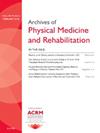The WeeBot: Development of a Unique Powered Mobility Device for Very Young Infants through Transdisciplinary Collaboration
IF 3.6
2区 医学
Q1 REHABILITATION
Archives of physical medicine and rehabilitation
Pub Date : 2025-05-01
DOI:10.1016/j.apmr.2025.03.023
引用次数: 0
Abstract
In this presentation we will discuss the transdisciplinary research approach used to develop a powered mobility device for infants and why collaborations between technologist and clinicians should start early, and on the clinical side. The WeeBot is a powered mobility device shown to provide independent, hands-free, and self-directed movement to infants as young as 6 months old. The control method is innovative: The device moves in the direction that the child leans, making it a more intuitive device than anything currently available. Additional safety features reduce the risks inherent in providing powered mobility to infants this young. The origin of the WeeBot as a research project began with a collaboration between a pediatric Occupational Therapist whose experience in early intervention provided the unsolved problem Roboticist with an interest in solving real world problems. Providing mobility is now viewed as a beneficial aspect of therapy, but the general approach is "movement for movements sake". The WeeBot team which had added a Pediatric Physical Therapist and Development Psychologist, believed that movement with purpose was the key to gains in future milestones. Current technologies struggle to provide this – most infants can't fully control devices that use joysticks/switches. The technologist understanding the problem but not bound by disciplinary history, could provide a unique perspective on the a solution and hence the WeeBot came to be. A start-up company, Assistance in Motion, founded by the core of the research team is now working to commercialize and make this device available to clinicians and parents.
WeeBot:通过跨学科合作为非常年幼的婴儿开发一种独特的动力移动设备
在这次演讲中,我们将讨论用于开发婴儿动力移动设备的跨学科研究方法,以及为什么技术专家和临床医生之间的合作应该尽早开始,并在临床方面。WeeBot是一种动力移动设备,可以为6个月大的婴儿提供独立、免提和自主的运动。控制方法是创新的:设备在孩子倾斜的方向移动,使其成为一个比现有的任何设备更直观的设备。额外的安全功能降低了为这么小的婴儿提供动力移动所固有的风险。WeeBot作为一个研究项目的起源始于一位儿科职业治疗师的合作,他在早期干预方面的经验让机器人专家对解决现实世界的问题产生了兴趣。提供活动能力现在被视为治疗的一个有益方面,但一般的方法是“为了运动而运动”。WeeBot团队增加了一名儿科物理治疗师和发展心理学家,他们认为有目的的运动是未来取得里程碑式成就的关键。目前的技术很难做到这一点——大多数婴儿不能完全控制使用操纵杆/开关的设备。技术专家了解问题,但不受学科历史的束缚,可以为解决方案提供独特的视角,因此WeeBot诞生了。该研究团队的核心成员成立了一家名为“运动辅助”(Assistance in Motion)的初创公司,目前正致力于将这种设备商业化,并使临床医生和家长可以使用这种设备。
本文章由计算机程序翻译,如有差异,请以英文原文为准。
求助全文
约1分钟内获得全文
求助全文
来源期刊
CiteScore
6.20
自引率
4.70%
发文量
495
审稿时长
38 days
期刊介绍:
The Archives of Physical Medicine and Rehabilitation publishes original, peer-reviewed research and clinical reports on important trends and developments in physical medicine and rehabilitation and related fields. This international journal brings researchers and clinicians authoritative information on the therapeutic utilization of physical, behavioral and pharmaceutical agents in providing comprehensive care for individuals with chronic illness and disabilities.
Archives began publication in 1920, publishes monthly, and is the official journal of the American Congress of Rehabilitation Medicine. Its papers are cited more often than any other rehabilitation journal.

 求助内容:
求助内容: 应助结果提醒方式:
应助结果提醒方式:


